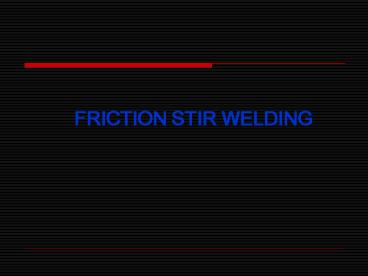FRICTION STIR WELDING - PowerPoint PPT Presentation
1 / 20
Title:
FRICTION STIR WELDING
Description:
FRICTION STIR WELDING Introduction Welding using friction as the major resource No filler material involved Welds created by, a) Frictional heating b) Mechanical ... – PowerPoint PPT presentation
Number of Views:1233
Avg rating:3.0/5.0
Title: FRICTION STIR WELDING
1
FRICTION STIR WELDING
2
Introduction
- Welding using friction as the major resource
- No filler material involved
- Welds created by,
- a) Frictional heating
- b) Mechanical deformation
3
History
- Invented by TWI in 1991 in England
- 28 organizations worldwide use FSW
4
Friction Welding
- Heat from mechanical energy conversion
- Linear friction welding
- Rotary friction welding
5
Friction Stir Welding
Rotating probe provides friction heat and
pressure which joins the material Sufficient
downward force to maintain pressure and to
create friction heat
Sufficient downward force to maintain pressure
and to create friction heat
Shoulder which creates friction heatand welding
pressure
Probe which Stir the material
6
Microstructure Analysis
A. Unaffected material B. Heat affected zone
(HAZ) C. Thermo-mechanically affected zone
(TMAZ) D. Weld nugget (Part of
thermo-mechanically affected zone)
7
Microstructure analysis
Optical micrographs of regions (a), (b) and (c)
of the stir nugget.
8
Joint Geometries
- It can be used in all positions,
- Horizontal
- Vertical
- Overhead
- Orbital
9
Material Suitability
- Copper and its alloys
- Lead
- Titanium and its alloys
- Magnesium alloys
- Zinc
- Plastics
- Mild steel
- Stainless steel
- Nickel alloys
10
Welding Steel using FSW
11
Tools Parameters
12
Common Tools
Fixed Pin Tool
Self Reacting Pin Tool
Adjustable Pin Tool
Retractable Pin Tool
13
Some of the FSW Machines
ESAB SuperStir TM machine FW28
ESAB Machine
14
Advantages
- Diverse materials Welds a wide range of alloys,
including previously un-weldable (and possibly
composite materials) - Durable joints Provides twice the fatigue
resistance of fusion welds. - Versatile welds Welds in all positions and
creates straight or complex-shape welds - Retained material properties Minimizes material
distortion - Safe operation Does not create hazards such as
welding fumes, radiation, high voltage, liquid
metals, or arcing - No keyholes Pin is retracted automatically at
end of weld - Tapered-thickness weld joints Pin maintains full
penetration
15
Comparison with other joining processes
FSW vs Fusion Welding
FSW vsRivetting
Reduced Part Count Reduced Production Time
Reduced Defect Rates Increase in Load Carrying
Capability Improved Fracture Performance
Eliminates Consumables Less Operator Dependent
Improved Mechanical Properties Reduced
Distortion Reduced Defect Rate Parent Metal
Chemistry Simplifies Dissimilar Alloy Welding
Fewer Process Variables Eliminates
Consumables Reduces Health Hazard
16
Disadvantages
- Work pieces must be rigidly clamped
- Backing bar required (except where self-reacting
tool or directly opposed tools are used) - Keyhole at the end of each weld
- Cannot make joints which required metal
deposition (e.g. fillet welds)
17
Barriers for FSW
- Special clamping system necessary
- Only for simple joint geometries (e.g. butt
joint) - License required from TWI
- Few applications in the construction industry
- Corrosion protection is needed
18
Future Developments
- Laser-assisted friction stir welding
- Possible use of induction coil and other mechanism
19
Conclusion
- An alternative to fusion welding
- Advanced technologies are in the offing
20
THANK YOU































